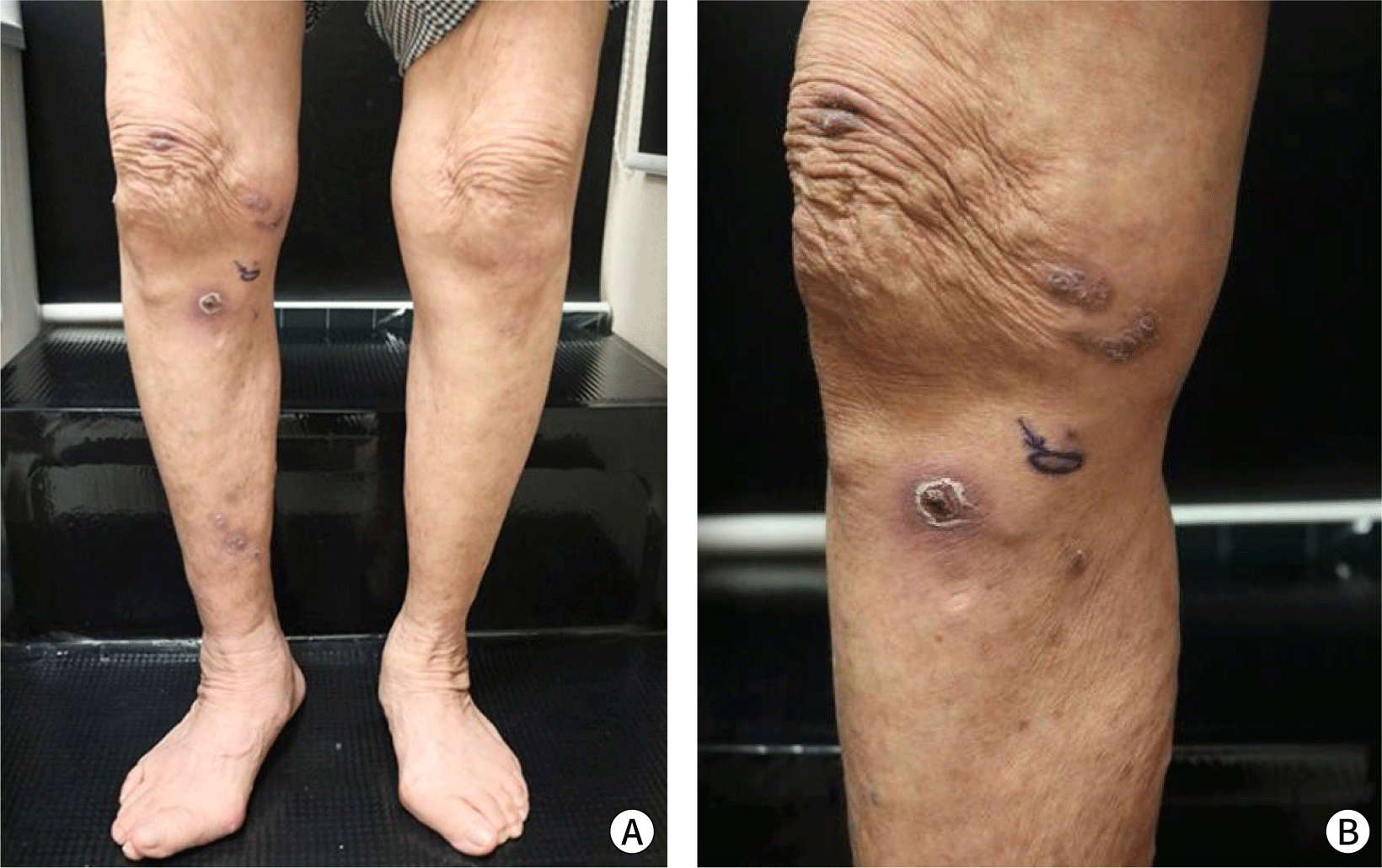Introduction
Nontuberculous mycobacterial infections are caused by mycobacteria other than Mycobacterium tuberculosis and Mycobacterium leprae. Nontuberculous mycobacteria are commonly found in the environment, particularly in water and soil, and are more frequently associated with skin diseases than M. tuberculosis [1]. The infections they cause present a broad spectrum of skin symptoms. Due to this diversity, these infections are often misdiagnosed, leading to delays in treatment [2].
Case presentation
A 77-year-old woman presented with multiple skin lesions on her right leg that had developed approximately 3 to 4 months previously. Aside from hypertension, she had no significant medical history and no known exposure to water or soil that might explain her condition.
A physical examination revealed several erythematous to maroon-colored crusted deep nodules arranged in a linear pattern on her right leg (Fig. 1).

She was initially treated for cellulitis, but her condition did not improve. Therefore, she was referred for further investigation.
A skin biopsy demonstrated granulomatous inflammation extending deep into the subcutaneous tissue (Fig. 2A, B). Acid-fast bacilli (AFB) were identified with Ziehl-Neelsen staining (Fig. 2C). PCR analysis for mycobacteria was also performed on the tissue specimen, and the results were positive. We used AdvanSure TB/NTM real-time PCR (LG Chem, Seoul, Korea); however, this system cannot define the exact type of tuberculosis. Attempts to culture the nontuberculous mycobacteria, both in a mycobacteria growth indicator tube and on Lowenstein-Jensen medium, were unsuccessful.

Treatment began with minocycline (50 mg twice daily), leading to gradual improvement over 3 months, but was halted due to gray hyperpigmentation at the treated sites. A switch to clarithromycin (500 mg daily) led to moderate improvement, but new lesions appeared after 4 months. Therefore, the regimen was modified to include isoniazid (200 mg per day) and rifampicin (450 mg per day), leading to noticeable clinical improvement within a month.
Discussion
The prevalence of skin infections caused by nontuberculous mycobacteria appears to be increasing. These infections manifest with a range of cutaneous symptoms, such as abscesses, cellulitis, sporotrichoid nodules, ulcers, and panniculitis. The diverse nature of these symptoms makes diagnosis challenging, necessitating a high degree of suspicion in relevant clinical contexts to ensure timely identification. Nontuberculous mycobacterial infections should be suspected in patients whose skin infections are resistant to standard treatments [3].
Infections that present in a 'sporotrichoid' form are characterized by multiple lesions along the superficial lymphatic vessels, resembling the lymphangitis observed in sporotrichosis [4]. Various mycobacteria, including Mycobacterium marinum, Mycobacterium kansasii, Mycobacterium avium complex, and Mycobacterium chelonae, are known to exhibit this sporotrichoid pattern [5].
The diagnosis of mycobacterial infection necessitates tissue biopsies to evaluate the presence of AFB and to culture tissue specimens. Molecular techniques, such as PCR, are increasingly utilized to accurately identify mycobacterial pathogens in tissue samples [5]. In this instance, AFB were detected histologically, and nontuberculous mycobacteria were confirmed through PCR, although the specific organism could not be cultured.
Treatment guidelines recommend susceptibility testing of mycobacterial isolates to optimize the choice of specific antimycobacterial drug combinations [5]. Due to the inability to isolate the causative mycobacterium, empirical treatments were administered, assuming an M. marinum infection, which typically demonstrates a sporotricoid pattern. There is no standardized treatment regimen for nontuberculous mycobacterial infections, owing to the rarity of cases and the absence of controlled trials. Common regimens for M. marinum include tetracyclines, specifically minocycline and doxycycline, trimethoprim-sulfamethoxazole, rifampicin, and clarithromycin. For resistant cases, a combination of rifampicin and ethambutol may be employed. The duration of therapy varies based on clinical response and can last up to 1 year [6]. It is advised to continue medication for at least 4–8 weeks after lesions have disappeared [7].
In conclusion, we report a case of nontuberculous mycobacterial infection presenting with a sporotrichoid distribution. Obtaining histopathology and conducting appropriate culture or molecular tests are essential for making the diagnosis.
